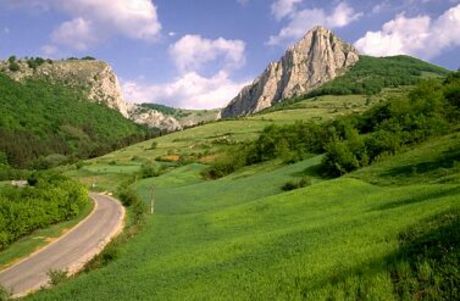Apuseni Mountains
The Apuseni Mountain range, in the western Carpathians, is a landscape of exquisite beauty and mystery. Here, you’ll find ancient legends of mountain spirits and rare species of wildlife, along with 4,000 caves, many of which can be explored. Scarisoara Glacier, a national monument, shelters the second largest underground glacier on the continent.
The Apuseni Mountains (Romanian: Munţii Apuseni, Hungarian: Erdélyi-középhegység) is a mountain range in Transylvania, Romania, which belongs to the Western Carpathians, also called Occidentali in Romanian. Their name translates from Romanian as Mountains "of the sunset" i.e. "western". The highest peak is "Cucurbăta Mare" (Hungarian: Nagy-Bihar) - 1849 metres, also called Bihor Peak. The Apuseni Mountains have about 400 caves.
The Apuseni Mountains do not present an uninterrupted chain of mountains, but possess many low and easy passes towards the Crişana and the Great Hungarian Plain. Going from south to north the principal groups are: the Munţii Metaliferi ("Ore Mountains") with the basaltic mass of the Detunata (1,148 metres (3,766 ft)) near Abrud; the Bihor Mountains, with romantic scenery and numerous caverns, with the highest peak the Curcubăta Mare (1,843 metres (6,047 ft)); to the east of this group are the Muntele Mare (highest peak 1,820 metres (5,970 ft)), to the southwest of Cluj-Napoca; the northermost chain is the Seş and Meseş Mountains.
With over 1500 caves located in the park, Apuseni is an explorer's paradise. Hodobana, a massive underground labyrinth that meanders more than 21 kilometers, is a "must-see" attraction, as is the Zgurasti Cave, which shelters a spectacular underground lake. There is also the Valea Rea, which is one of the world's most significant caves, containing over 35 different types of minerals.
Another unique phenomenon in the park's landscape is the Groapa Ruginoasa. This colossal ravine has a diameter of about 450 meters and is over 100 meters deep. It was formed by water erosion that cut through the layers of sandstone and red-violet clays.
Apuseni is also home to an excess of alpine sports. Hiking, snowshoeing, and skiing are just a few of the many sports that draw visitors to the area.
Due to the ever-changing mountain climates, the Apuseni Natural Park never sits still. The region is constantly evolving, with peat bogs emerging in the higher altitudes. The park is also home to over 1,550 different plant species. Spruce forests fill the mountain sides, while wild cherries and black walnuts grow in the meadows.
One of the most extraordinary places in the park is the Padis-Cetatile Ponorului Karst visitor area. It's an area comprised of steep rock walls, wild running water and deep caves.
Recently, carnivorous wildlife, which was previously unknown to science, was discovered in some of the mountain's caves. These discoveries, combined with the already vast numbers of bear, lynx and wolves, make the region a truly remarkable habitat for wildlife.
Tourism continues to steadily grow in the region andthe Apuseni Natural Park has been able to meet this challenge. Developing tourist areas like Vladeasa and Albac offer top-notch accommodations and easy access to the park's attractions.
Having four distinct seasons is also a plus to the region. Tourism is spread out evenly through the year, allowing programs to be implemented to ensure the rehabilitation of the park's hiking and skiing trails. Romania has also reached out to other countries to discuss new and evolving environmental issues and measures. Apuseni Natural Park is a special place and the government plans on it remaining this way.
Located in the heart of Transylvania, and rather close to Cluj-Napoca, old university center, the area from the Apuseni Mountains presently included in the Apuseni Nature Park has been visited and studied since the time of the Austro-Hungarian Empire.
The oldest tourist trails in the area, dating from the 1900's, were described and marked by Czárán Gyula, a tireless traveler in the Apuseni.
The first initiatives to establish a park in this area belong to the scientist Emil Racoviţă, who at the first Congress of the Romanian Naturalists in 1928 has clearly formulated the purpose and the objectives of a large protected area in the Apuseni Mountains. In the '50s, following important discoveries in endokarst exploration, new steps in this direction were taken by Marcian Bleahu.
Other scientific (but not only) personalities, who, by their studies and efforts in the field of nature protection, linked their name with the Apuseni Mountains area are Zeno Oarcea, Iosif Viehmann, Anna Marossy, Valeriu Puşcariu and Nicolae Boşcaiu, Cristian Pop and many others.
The first scientific documentation regarding the park establishment was prepared in the '70s, and was accompanied by a first map of the proposed limits. The fact that this is one of the last European naturally forested karst of large size was taken into account.
The first official act through which the "Apuseni National Park" was declared was the Ministry Order 7/1990, followed after ten years by Law 5/2000 regarding the territorial planning, Section III - Protected areas, where it is mentioned as the "Apuseni Mountain Nature Park".
In 1992, the Institute of Biological Research in Cluj-Napoca realized a "Substantiation study regarding the organization of a network of protected areas in Romania", which was the basis for the final decision to establish the park.
By the Government Decision 230/2003, the limits of the Apuseni Nature Park were established, resulting a surface of 75.784 ha. In 2004, the Administration of the park was formed, as a subunit of the National Forest Authority - Romsilva, Oradea Forestry Directorate, by the signing of an administration contract between the NFA-Romsilva and the Ministry of Environment and Water Management.




